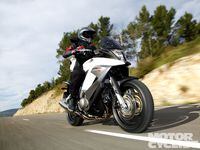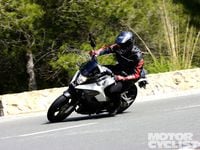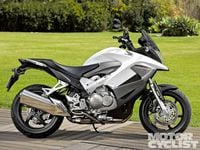Halfway up the gloriously twisty road leading up the west coast of Mallorca, my feelings for Honda's new Crossrunner are switching from admiration to frustration almost as often as the road changes direction. Most of the time I'm impressed by the Honda, loving its storming acceleration and especially the soulful intake moan as it charges out of yet another hairpin.
But occasionally a bend tightens unexpectedly and the rather heavy, slow-steering machine requires a bit of concentration and effort to adjust, or its rear shock gives a squirm of protest on acceleration. Then I find myself wishing Honda had invested more development effort to create a lighter, sharper, purpose-built adventure bike, rather than a revamped VFR that it could have released a decade ago.
Honda planned the Crossrunner around the faithful 782cc, 90-degree V4 engine from the VFR800 Interceptor introduced in 2002. Big Red also opted to utilize that sportbike's chassis, which is of an even older vintage-the twin-spar aluminum frame and single-sided swingarm are little changed from those of the '98-model VFR. The Crossrunner also uses the old bike's ABS-equipped brakes and suspension.
The quad-cam, 16-valve V4 is internally unchanged, but Honda lengthened the intake trumpets and tweaked the exhaust to improve bottom-end torque. The VTEC variable-valve system has been retuned to cut in gradually between 6600 and 6800 rpm, rather than abruptly at the higher figure as before. The result is more power between 3000 and 6000 rpm, but slightly less thrust between 6500 and 10,000 rpm.
Bodywork is all new, of course. The aim was to create a sort of two-wheeled SUV, with at least a notional ability on slightly rough surfaces; hence the taller look. But Honda didn't want a bike that only tall people could ride, so a thinner seat helps keep the rider's perch to a reasonable 32.1 inches. The riding position is almost bolt-upright, looking out over a digital instrument panel shared with the new CBR600F.
Heading though an urban area outside our hotel in the southern part of this Spanish island, the Crossrunner lived up to its easy-rider billing. It pulled almost from idle, with crisp fuel-injection response and generous steering lock that made flicking through traffic pleasingly effortless.
When we got out onto faster roads the Crossrunner came alive, reminding me just what a brilliant engine Honda's smaller V4 has always been. This retuned version is arguably the best yet, and certainly felt just right in this platform. With even more low-rev power than before, acceleration was as effortless as it was strong. A tweak of throttle sent the bike hurtling forward, rarely needing a dab down through the six-speed gearbox. The stubby windscreen gave little protection, merely diverting noisy turbulence at my head, though shorter riders seemed happier. It's a shame the standard windscreen isn't adjustable.
The same is true of the seat, which would benefit from a height-adjusting spacer like BMW's GS models or Triumph's Tiger 800s. Some taller riders found their legs cramped by the low seat and relatively high footpegs, though I didn't have that problem. Comfort in other respects seemed fine, though we didn't ride far enough to confirm whether the broad seat was as good as it looked.
For me, the Crossrunner motor's key attribute wasn't power; it was soul. Cracking the throttle open quickly reminded me why I've owned several Honda V4s over the years. At all revs the bike had that smooth-yet-involving feel that somehow only that engine configuration can produce. And most of all, its acceleration was accompanied by a glorious, uniquely V4 induction sound that hardened to a stirring snarl as the VTEC cut in just before 7000 rpm.
The 'Runner handled those ultra-nadgery roads reasonably well, although several times I found myself wondering how much better it could have been if Honda had taken the trouble to develop a lighter, more sophisticated chassis. Steering geometry and suspension are a compromise. Raising the bike's rear end while keeping the rake unchanged increased trail, which was presumably why the bike needed a firm nudge on its handlebars to get it down into a tight bend. And if the road tightened up unexpectedly, it needed another conscious input to adjust its line.
The Crossrunner certainly handled and stopped well enough to make me choose the twistiest route back from our lunch stop, and to make for an enjoyable and rapid journey. Occasionally, I still found myself wishing the bike was lighter than its 530-lb. curb weight. But most of the time I was just enjoying pitching it into the turns, and especially cracking the throttle open at every opportunity to feel (and hear) that fantastically responsive and soulful V4 motor.
A new chassis would have helped make the ride even quicker and more entertaining. But if Honda had spent more time and money on development and high-tech parts, it wouldn't be able to sell the Crossrunner for such a competitive price. It's roughly 10 percent less expensive than the VFR in Europe, so it's not bad value for a versatile, reasonably practical bike that delivers its design team's aim of easy fun. Shame American riders won't get the chance to discover that for themselves-at least not this year.
tech SPEC
EVOLUTION
Honda's venerable VFR800 repackaged in adventure-bike bodywork.
RIVALS
BMW F800GS, Yamaha Super Tenere, Suzuki V-Strom, Triumph Tiger 800.
TECH
Engine type: l-c 90-deg. V4
Valve train: DOHC, 16v w/VTEC
Displacement: 782cc
Bore x stroke: 72.0 x 48.0mm
Compression: 11.6:1
Fuel system: EFI
Clutch: Wet, multi-plate
Transmission: 6-speed
Claimed horsepower: 102 bhp @ 10,000 rpm
Claimed torque: 54 lb.-ft. @ 9500 rpm
Frame: Aluminum twin-spar
Front suspension: Showa 43mm fork with adj. spring preload
Rear suspension: Showa shock with adj. spring preload and rebound damping
Front brake: Dual Nissin three-piston calipers, 296mm discs w/ABS
Rear brake: Nissin two-piston caliper, 256mm disc w/ABS
Front tire: 120/70R-17 Pirelli Scorpion Trail
Rear tire: 180/55R-17 Pirelli Scorpion Trail
Rake/trail: 25.0o/4.5 in.
Seat height: 32.1 in.
Wheelbase: 57.6 in.
Fuel capacity: 5.7 gal.
Claimed curb weight: 530 lbs.
Colors: Red/gray, black/gray, white/gray
Availability: na
Warranty: 12 mo./unlimited mi.
Contact: American Honda Motor Co.
1919 Torrance Blvd.
Torrance, CA 90501
310.783.3745
www.powersports.honda.com
**VERDICT: ** 3.5 out of 5 stars
Comfortable, versatile and fun, though it could use a chassis upgrade.

















/cloudfront-us-east-1.images.arcpublishing.com/octane/QCZEPHQAMRHZPLHTDJBIJVWL3M.jpg)
/cloudfront-us-east-1.images.arcpublishing.com/octane/HXOUJXQWA5HBHGRO3EMJIGFMVI.jpg)

/cloudfront-us-east-1.images.arcpublishing.com/octane/3TIWWRV4JBBOLDVGRYECVVTA7Y.jpg)
/cloudfront-us-east-1.images.arcpublishing.com/octane/KIX5O23D5NAIBGFXBN3327DKZU.jpg)
/cloudfront-us-east-1.images.arcpublishing.com/octane/7GJYDUIPXRGMTMQKN6ONYOLBOU.jpg)
/cloudfront-us-east-1.images.arcpublishing.com/octane/MUQLOVLL2ZDGFH25ILABNBXKTI.jpg)
/cloudfront-us-east-1.images.arcpublishing.com/octane/TNOU5DNE2BC57MFPMGN2EIDXAM.jpg)
/cloudfront-us-east-1.images.arcpublishing.com/octane/GTCXACQGJ5HAPDTGWUQKDEH44E.jpg)
/cloudfront-us-east-1.images.arcpublishing.com/octane/S35YGSEMEZB4BLTDJTSZPF4GLA.jpg)
/cloudfront-us-east-1.images.arcpublishing.com/octane/5UOT6HPX2JFMRJAX6EH45AR4MQ.jpg)
/cloudfront-us-east-1.images.arcpublishing.com/octane/OKWOJWAKP5EP3OACCRRWPCIX2Q.jpg)
/cloudfront-us-east-1.images.arcpublishing.com/octane/2WF3SCE3NFBQXLDNJM7KMXA45E.jpg)
/cloudfront-us-east-1.images.arcpublishing.com/octane/G4MG6OUCJNBSHIS2MVVOTPX65E.jpg)
/cloudfront-us-east-1.images.arcpublishing.com/octane/IIGGWFOTOJGB7DB6DGBXCCMTDY.jpg)
/cloudfront-us-east-1.images.arcpublishing.com/octane/QSTCM6AVEZA5JJBUXNIQ3DSOF4.jpg)
/cloudfront-us-east-1.images.arcpublishing.com/octane/U4I7G625B5DMLF2DVIJDFZVV6M.jpg)
/cloudfront-us-east-1.images.arcpublishing.com/octane/B6XD6LS6IVCQPIU6HXDJSM3FHY.jpg)
/cloudfront-us-east-1.images.arcpublishing.com/octane/ICL63FEDDRDTTMINYICCEYGMDA.jpg)
/cloudfront-us-east-1.images.arcpublishing.com/octane/FCGZHQXRBZFLBAPC5SDIQLVF4I.jpg)
/cloudfront-us-east-1.images.arcpublishing.com/octane/WNOB6LDOIFFHJKPSVIWDYUGOPM.jpg)

/cloudfront-us-east-1.images.arcpublishing.com/octane/X33NU3E525ECRHXLNUJN2FTRKI.jpg)
/cloudfront-us-east-1.images.arcpublishing.com/octane/6KKT5NNL2JAVBOXMZYS5ZO76YA.jpg)